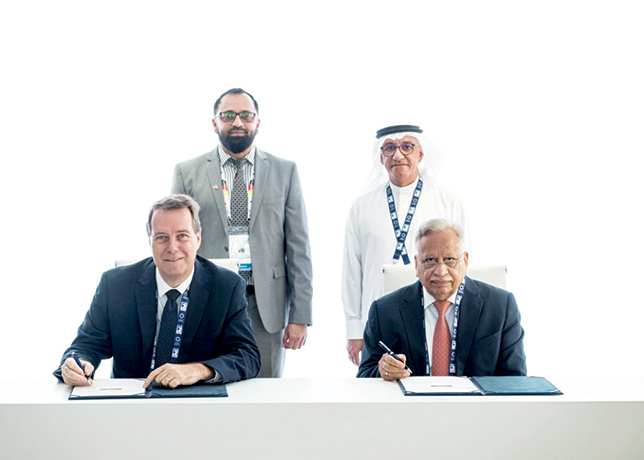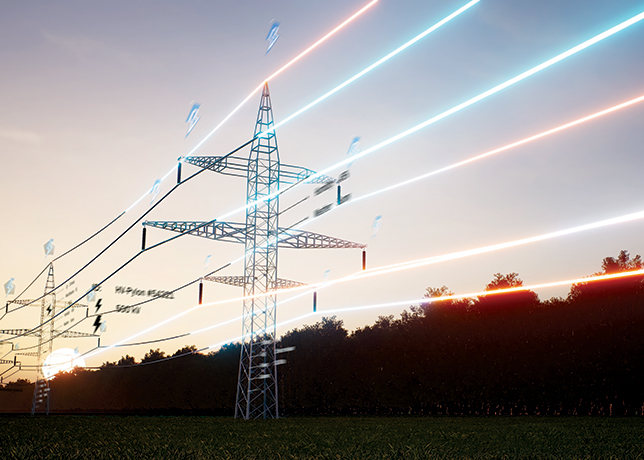.jpg)
 The El Wastani Gas Plant located in the Nile Delta near Damietta
The El Wastani Gas Plant located in the Nile Delta near Damietta
From friendly legislation to improving infrastrucutre and facilities, Egypt is making the right moves to grow its oil and gas sector, which is at a turning point
Things have improved drastically for Egypt in the oil and gas sector in a matter of four years with its new-found fortunes. Once an importer of fuel, the country achieved self-sufficiency in gas in 2018 and is now ready to punch above its weight.
The turning point for the Arab world’s most populous country was the discovery of the massive Zohr field by Italian energy major Eni in 2016, thus flagging off the race for hydrocarbon exploration along the Nile Delta and western desert.
International exploration companies were quick to sniff success and riches. The Egyptian government wanted to make the best of the opportunity and started doling out exploration rights and legislating laws to create a business-friendly environment. So far, the sailing has been smooth.
On the African continent, Egypt is already a significant oil producer and refiner. It is the largest non-Opec oil producer and third-largest dry natural gas producer. The country also serves as a major transit route for oil shipped from the Arabian Gulf to Europe and to the US through the crucial Suez Canal waterway.
According to figures available, Egypt’s crude oil production in March 2020 was 526,359 barrels per day (bpd) down from 2019 figures due to the Covid-19 pandemic.
 |
El Molla ... aiming for energy self-sufficiency |
During 2019, Egypt recorded an all-time high output of 1.9 million barrels of oil equivalent over the 12-month period. Natural gas production rose to unprecedented levels during the year, reaching 7.2 billion of cubic feet (bcf) per day. Total petroleum output stood at 84.2 million tonnes, rising by 7 per cent year-on-year from 2018.
It was the current Minister of Petroleum and Mineral Resources, Tarek El Molla’s dream to turn Egypt once again into a leading gas exporter.
In July, he signed 12 agreements with global oil and gas giants: Chevron, Edison, BP, Total, Royal Dutch Shell, Nobel, Kuwait Foreign Petroleum Exploration Company, and the UAE’s Mubadala, to search for oil and gas i n the Red Sea, in the Western Desert and in the exclusive economic zone (EEZ) in the eastern and western Mediterranean with investments up to $1 billion.
Six of these 12 concessions are in the western Mediterranean in areas including North Dabaa, North Sidi Barani, North Salloum (near the Libyan borders) – North El Amreyia, Northern Ras Kanayes, North Marina. The other six are in the western desert, the Red Sea and the Egyptian EEZ in the East Mediterranean.
In the last six years, El Molla’s ministry has signed 84 agreements to drill 351 wells for oil and gas exploration worth an investment of $15 billion.
According to a Ministry of Planning and Economic Development (MPED) report, by the first half of the 2019-2020 fiscal, the energy sector had completed 156 projects worth a total investment of nearly $2 billion in the oil, electricity, and renewable energy sectors. The petroleum sector alone has implemented nine projects worth over $700 million.
The report showed that the natural gas sector grew at a rate of 4.5 per cent during H1 2019/20, while the petrochemical sector achieved a 14.2 per cent growth. Additionally, the number of projects increased by 29 per cent, compared to the same period in fiscal year (FY) 2018/19.
Egypt in 2019 achieved record high levels across oil and gas fields during 2019, according to a report released by the Ministry of Petroleum and Mineral Resources. During the year, it signed eight new oil and gas exploration agreements with international companies with minimum investments of $179 million for the drilling of 34 wells.
A total of 17 agreements have been ratified by the Egyptian parliament to be signed with minimum investments of more than $1 billion and a signature bonus of $173 million for the drilling of 86 wells.
Moreover, 20 contracts have been signed for the development of fields in the Western Desert with a total signature bonus of $10.3 million.
In 2019, Egypt made 55 oil and gas discoveries, including 40 oil discoveries and 15 gas discoveries in the Mediterranean Sea, the Western Desert, the Eastern Desert, Gulf of Suez, Nile Delta, and Sinai.
In June this year, new oil was discovered at Geisum Concession area, in Egypt's Southern Gulf of Suez, shallow waters, with an initial production rate of 2,000 barrels per day of crude oil. The new discovery is estimated to hold about 70 million barrels of extractable crude oil. The discovery was made by Petro Gulf Misr.
To modernise and improve the oil and gas sector, the Minister of Petroleum and Mineral Resources launched a four-year project in 2016 in line with Egypt’s 2030 vision. The project aims to design and implement an integrated transformative programme for the sector and entails the realization of a simplified sector structure with autonomous and independent entities focused on operations across value chain segments.
GAS SELF-SUFFICIENCY
In December 2018, Egypt achieved a major milestone when it announced gas self-sufficiency, with overall production increasing to around 5.7 bcf per day mainly from the Zohr gas field. It was rapid growth for gas from then onwards.
Egypt is one of the first 10 countries to own the highest reserves of natural gas in the deep water reserves (approximately 18.52 trillion cubic feet (TCF)) and is able to extract with economic value.
The Zohr field is Mediterranean’s largest and produced 11.3 billion cu m of gas in H1 2019, 3.6 times more than it did in the same period the year before, according to a statement by Rosneft. By 2019-end, gas output was expected to hit 76 million cu m of gas per day. Production is being undertaken by a consortium led by ENI, which holds a 50 per cent stake, as well as Rosneft (30 per cent), BP (10 per cent) and Mubadala Petroleum (10 per cent).
In July 2020, a consortium of Eni, BP and Total successfully drilled the first exploration well in the North El Hammad license, in the conventional Egyptian waters of the Nile Delta, on the prospect called Bashrush.
The well discovered a single 152 m thick gas column within the Messinian age sandstones of the Abu Madi formation with excellent petrophysical properties. The well will be tested for production.
Additionally, 11 production wells, three offshore pipelines, an offshore management platform, and all eight production trains of the gas treatment plant have been commissioned.
Also in July 2020, new gas was discovered in Abu Sennan concession at the Western desert by the General Petroleum Company (GPC). The production is estimated to be 28 million cu ft per day (mcbf/d) in addition to 1,180 barrels of condensates per day.
Earlier in June 2020, also in Abu Sannan, the El Salmiya -5 well started producing 18 mcbf/d of gas and 4,100 barrels of crude oil.
There is also huge potential for shale gas discovery in Egypt. According to the US Energy Information Administration (EIA), the country’s reserves of unconventional hydrocarbons exceed 100 trillion cu ft of recoverable shale gas. The most attractive formations are located in the northwest of the country. Many international oil companies (IOCs) having expressed interest in undertaking explorations in those areas.
Early this year, the Egyptian government formed a fuel automatic pricing committee to set fuel prices according to global prices, besides amending existing exploration agreements.
LIQUEFIED NATURAL GAS (LNG)
In the 2018-19 fiscal, Egypt exported the equivalent of 172.8 billion cubic feet (bcf) LNG, according to the Egyptian Natural Gas Holding Company’s (EGAS) annual report.
For liquefaction and export, Egypt has two LNG plants that include three LNG trains, with a combined annual capacity of approximately 610 billion cubic feet (bcf) or 12.7 million tons per year. However, the plants have been idled or running at less than their potential capacity and can be used for exports.
The bulk of Egypt’s gas LNG exports goes from the Idku liquefaction terminal, run by Egyptian LNG — a joint venture between state-owned Egyptian General Petroleum Corporation and EGAS, and Royal Dutch Shell, Petronas and Engie. The terminal has two operational LNG trains, each with a capacity of 3.6 million tonnes, with room for an additional four trains on site.
Egypt’s second gas liquefaction plant is at Damietta. But the terminal was idled in 2012 after feedgas to the plant was diverted for use on the domestic market. Efforts to restart it were complicated by a lawsuit filed by UFG against Egypt in 2014.
Damietta has an annual capacity of up to 5 million tonnes and can store 130,000 tonnes of LNG, government websites show. It was expected to resume operations by June 2020.
PETROLEUM TRANSPORTATION
Egypt depends on a variety of means to transport petroleum products. It has a wide network of gas pipelines, the most significant of which is the Arab Gas Pipeline which extends across northern Sinai via Al-Arish to Jordan and on to Syria and Lebanon. The second is the Arish-Ashkelon pipeline, owned by the East Mediterranean Gas Company (EMG).
From 2015 to 2019, the number of petroleum pipelines has increased by 38 per cent to reach a total of 80 pipelines, in addition to a 20 per cent increase in the number of LPG and product pipelines. This has increased the network’s total length to reach 5,842 km.
In 2018-19, the SUMED pipeline transported around 41 per cent of petroleum products, followed by 37.2 per cent by other pipelines. Furthermore, trucks, tankers, and railways transported 18 per cent, 3.5 per cent, and 0.2 per cent of Egypt’s petroleum products, respectively, according to the Central Agency for Public Mobilisation and Statistics’ (CAPMAS) Annual Bulletin of Petroleum Materials Means of Transportation and Natural Gas in Egypt 2018/2019.
RENEWABLES
Egypt aims to launch 691 green projects worth nearly $30 billion in the fiscal year 2020-21, according to Minister of Planning and Economic Development Hala El-Said, adding that $2.3 billion has already been allocated for this purpose in the 2020-21 general budget and which constitutes 14 per cent of the total public investments for the year.
El-Said said the green projects for renewable energy aimed to meet the growing demand for energy. It is anticipated that they will meet the sustainable development plan, represented by wind power stations in the Gulf of Suez, which have a capacity of 25 MW.
This is in addition to the 50 MW photovoltaic station in Zaafarana, and the local development sector’s solid waste management project, which aims to raise the efficiency of cleaning system.














































































